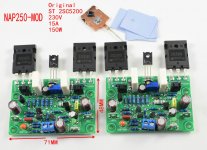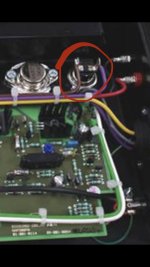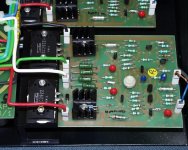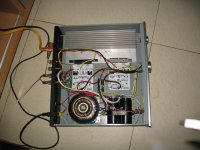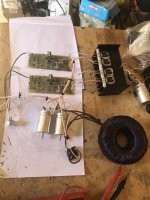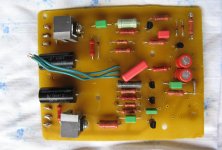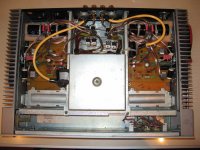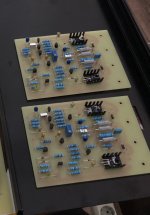So, not realy required but necessary for a consumer product (turning on with volume up and so).Relay need for delay output off when preamp poweron
I wil first wil build the original boards (with original Zobel) up this month trying to find missing original parts. Than i wil test them on my NAC72. Step two wil be the custom "Naim" preamp.
Wil post pics and updates.
Wil post pics and updates.
If you not use relay and connect preamp When you power on power amp and preamp you listen hi sound click push in speakers 🙂)) this is not good for speakers 🙂))So, not realy required but necessary for a consumer product (turning on with volume up and so).
because relay wait when starts process in preamp is ending after that relay on and permit output signals to input power amp
Nap140 actually has some bugs that need to be corrected.
I do not recommend that DIY have the same structure as the original machine.
His VBE bias triode needs to be installed on the radiator. Ensure thermal stability.
Sorry, I'm not advertising. I just found the pictures I took before.
Used to tell you that you need to modify it like this.
I do not recommend that DIY have the same structure as the original machine.
His VBE bias triode needs to be installed on the radiator. Ensure thermal stability.
Sorry, I'm not advertising. I just found the pictures I took before.
Used to tell you that you need to modify it like this.
Attachments
Thanks. But then it's not the original design but an "improved" version. That would mean that al the original boards out there never did or do function correct. I don't believe that. I have the original boards. I am aware of the VBE bias an therminal stabilisation of the small closed chassis in the design Naim did.
I wil try to stay as close as posible by that specs of chassis and heatsink surface.
I wil try to stay as close as posible by that specs of chassis and heatsink surface.
If you build original amp you not need relocate VBE bias triode because all work with internal case amp temperatureNap140 actually has some bugs that need to be corrected.
I do not recommend that DIY have the same structure as the original machine.
His VBE bias triode needs to be installed on the radiator. Ensure thermal stability.
Sorry, I'm not advertising. I just found the pictures I took before.
Used to tell you that you need to modify it like this.
but if you build not original design some like Chinese you right because Chinese boards is not adaptive to use vbe bias triode without radiator 🙂)
also if you very scary about overheating just add thermal fuse like on photo in attachment
p.s need use original parts and boards 🙂)
Attachments
Last edited:
I
I testing the original boards and you do not need relocate vbe bias triode to radiator
All work fine and not warm 🙂)
All correctThanks. But then it's not the original design but an "improved" version. That would mean that al the original boards out there never did or do function correct. I don't believe that. I have the original boards. I am aware of the VBE bias an therminal stabilisation of the small closed chassis in the design Naim did.
I wil try to stay as close as posible by that specs of chassis and heatsink surface.
I testing the original boards and you do not need relocate vbe bias triode to radiator
All work fine and not warm 🙂)
What value of resistors will you use for series 470pf capacitors 🙂 680 (& parallel 560ohm ), 470 (&150) or 33(&27) ?
Last edited:
It does need a small, sealed box for early Naim models to regulate bias optimally and even then, bias doesn't settle for some models, for up to 1/2 hour from turn-on in cool conditions. Strictly speaking, that actually does translate to "do not function correctly", at least until the whole amplifier device has warmed up to a normal operating temperature range where bias is set....... That would mean that al the original boards out there never did or do function correct. I don't believe that. I have the original boards. I am aware of the VBE bias an therminal stabilisation of the small closed chassis in the design Naim did.
I wil try to stay as close as posible by that specs of chassis and heatsink surface.
Even so, the long thermal lag assumes that program levels are fairly constant and there is no need for a rapid response to significant changes in output level. That is somewhat risky but certainly in line with other quirky aspects of Naim's early products. The comments LJM is passing on though, are about his design mods which do a more dependable job of compensating for the thermal lag problem with this particular modified clone design of his.
I'm glad that someone can finally agree with my suggestion.It does need a small, sealed box for early Naim models to regulate bias optimally and even then, bias doesn't settle for some models, for up to 1/2 hour from turn-on in cool conditions. Strictly speaking, that actually does translate to "do not function correctly", at least until the whole amplifier device has warmed up to a normal operating temperature range where bias is set.
Even so, the long thermal lag assumes that program levels are fairly constant and there is no need for a rapid response to significant changes in output level. That is somewhat risky but certainly in line with other quirky aspects of Naim's early products. The comments LJM is passing on though, are about his design mods which do a more dependable job of compensating for the thermal lag problem with this particular modified clone design of his.
I don't know why all my suggestions. Basically, they will be denied. Although I think these are the right suggestions.
In fact, we can use three wires. Connect the VBE transistor. It is installed on the radiator. It does not need to modify the PCB. Although a little ugly.
In fact, I have observed the original Naim. And copied. They all have the same problem.
I used to drive machines. Set aside for one night. Observe the changes of VBE.
The result was that the temperature exceeded 100 degrees the next day.
This is not a complicated problem. Naim's bug is not just this one. Sorry, my English is not good. So it's hard to explain
I didn't find the black box on the machine produced by Naim.
And I found that the positive and negative poles of his signal capacitance were wrong.
This is the machine. Static current less than 10mA
No music played. Leave for 10 hours. The temperature rises from 20 degrees to about 120 degrees. I scalded my hand with a bubble.
Although this was in 2006. I still remember clearly now.
Attachments
Last edited:
You have this problem because you not use the original transistors in VBE bias and others.Static current less than 10mA
No music played. Leave for 10 hours. The temperature rises from 20 degrees to about 120 degrees. I scalded my hand with a bubble.
Although this was in 2006. I still remember clearly now.
Now time old transistors is not production and you need find same to H21e
If you have original VBE bias triodes his H21e not permit overheating in output stage 🙂)
but if you clone have others transistors in VBE bias you need relocate him to radiator.
Please watch in attachment photo this setup of old NAP amp working about 10 hours and not overheating.
Attachments
Last edited:
So in my very early clones of nap 140 in 2009 year I have same problem with overheating and I relocate VBE bias to radiator (very early clone of nap 140 )Static current less than 10mA
No music played. Leave for 10 hours. The temperature rises from 20 degrees to about 120 degrees. I scalded my hand with a bubble.
Although this was in 2006. I still remember clearly now.
Green wires in attachment photo for VBE bias triode 🙂)
Oh long long time ago …🙂)) in 2009 year I not think about anything I just clone NAP140 with audiophiles parts 🙂)) hhhhh
Attachments
Nice your clone of nap140Although this was in 2006.
Power caps with correct ground 👍🏻👍🏻👍🏻
This clone are still working in yours music system ?
NO。 I do not recommend NAP140. It's not good.Nice your clone of nap140
Power caps with correct ground 👍🏻👍🏻👍🏻
This clone are still working in yours music system ?
I recommend a modified version of NAP250 MOD.
#24 reference resources
Member
Joined 2009
Paid Member
I fixed the bias issue with a simple change
https://www.diyaudio.com/community/...by-julian-vereker.302454/page-18#post-5011146
https://www.diyaudio.com/community/...by-julian-vereker.302454/page-18#post-5011146
I think the original design boards is better and have a over current protect circuitNO。 I do not recommend NAP140. It's not good.
I recommend a modified version of NAP250 MOD.
#24 reference resources
But size of boards is big 🙂
Attachments
Last edited:
Member
Joined 2009
Paid Member
Over current protection is perhaps handy when you are selling amps to consumers but for DIY there's no reason to include and it carries the risk that most of these protection schemes are inadequate or worse, impact sound quality.
The thermal management idiosyncrasies of the original design can be debated but I'm confident that Julian would have eventually upgraded the design and if I can be a little proud of my work, he may have adopted the solution I used and linked previously.
I also wouldn't be a slave to the old pcb design. There are more than one way to skin that cat but it's fun to copy a classic.
The thermal management idiosyncrasies of the original design can be debated but I'm confident that Julian would have eventually upgraded the design and if I can be a little proud of my work, he may have adopted the solution I used and linked previously.
I also wouldn't be a slave to the old pcb design. There are more than one way to skin that cat but it's fun to copy a classic.
So you not use current limiter but use relay protect ?Over current protection is perhaps handy when you are selling amps to consumers but for DIY there's no reason to include and it carries the risk that most of these protection schemes are inadequate or worse, impact sound quality.
The thermal management idiosyncrasies of the original design can be debated but I'm confident that Julian would have eventually upgraded the design and if I can be a little proud of my work, he may have adopted the solution I used and linked previously.
I also wouldn't be a slave to the old pcb design. There are more than one way to skin that cat but it's fun to copy a classic.
Please read my previous posts about 13years ago I clone Naim amp without current protection too 🙂) But after 12 years I think current limiter is good solution for use amp without output relay.
Another question you have original old Naim Amp or preamp ? Maybe you listen original old Naim in yours home stereo system ?
P.s different parts different sound 🙂)
Last edited:
Member
Joined 2009
Paid Member
Yes, I use a SS output relay, it’s something I copied from others on this forum who have found them to be sonically transparent. This isn’t to protect the amp from shorts at the output like a current limiter, it’s to protect the speakers in case the amp gets fried. It is also useful for eliminating turn on and turn off noises.
I copied a Bryston current limiter circuit once, but I was not happy with that project so I scrapped it before I had formed an opinion of any sound impact from the limiter circuitry. So I can’t say from expetience if they sound bad, I’ve avoided them based on what has been written by others but the arguments against it have been good enough for me, especially as my amps are rarely exposed to the risk of damage from over current and it’s less parts if I exclude the extra circuitry.
I don’t own any old Naim equipment myself, I just like building stuff.
I copied a Bryston current limiter circuit once, but I was not happy with that project so I scrapped it before I had formed an opinion of any sound impact from the limiter circuitry. So I can’t say from expetience if they sound bad, I’ve avoided them based on what has been written by others but the arguments against it have been good enough for me, especially as my amps are rarely exposed to the risk of damage from over current and it’s less parts if I exclude the extra circuitry.
I don’t own any old Naim equipment myself, I just like building stuff.
- Home
- Amplifiers
- Solid State
- NAIM rebuild boards NAP 140 and NAC
